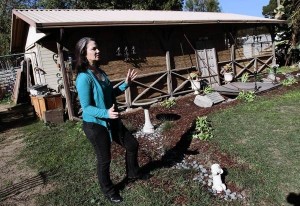Rain gardens capture water before it becomes urban runoff
The shallow depressions are surrounded by dirt berms and planted with climate-appropriate flowering plants. More than 185 of the gardens have been installed in northeast San Fernando Valley yards.
Source of this article: The Los Angeles Times, December 16, 2012
Watching water stream under parked cars and through the gutters every time it rained made Alice Abler cringe.
“What a terrible waste,” Abler recalled thinking, pondering all the pollutants being swept down drains and into waterways.

Alice Abler has added several ornamental features to her rain garden, including a watering tray where mourning doves come to drink.
Her chance to act came with a new program that provides homeowners with free rain gardens installed in their yards. These shallow depressions surrounded by dirt berms and planted with climate-appropriate flowering plants are designed to hold rainwater from rooftops and paved surfaces and keep it from flowing to streets.
The program allows homeowners to become environmental stewards, said Marcus Castain, founder and chief executive of Generation Water, an L.A.-based nonprofit organization that seeks new ways to reduce water usage.
Most rainwater travels over concrete and asphalt and picks up vehicle fluids, trash and other contaminants, which are then carried through sewers to the ocean. The untreated water, called urban runoff, is considered the biggest source of pollution in California’s rivers and the ocean, officials of Generation Water said.
Environmentalists say the first inch of rain carries almost all the polluted runoff. A rain garden captures the water and allows it to be filtered into the soil rather than entering storm drains. And there are other benefits:
“A lot of people think it looks beautiful,” Castain said. “It’s going to reduce your water bill … and it takes less effort to maintain than turf.”
Generation Water worked with the environmental nonprofit group TreePeople and the Los Angeles Department of Water and Power to launch the rain gardens pilot program in October. So far, more than 185 rain gardens have been installed in yards in the northeast San Fernando Valley.
This area was selected because its soil is silky sand, providing “good infiltration potential,” said Eric Yoshida, a civil engineering associate with the DWP.
Provided that a homeowner has a large enough roof and yard and an adequate gutter system, a rain garden can be installed by cutting out a portion of turf and surrounding it with a dirt ridge. The hollow is planted with flowering plants, such as hot lips sage, then covered with mulch and pebbles. Existing irrigation is capped off.
Yoshida estimated that up to 1.85 million gallons of storm water would be captured by the installation of 310 rain gardens, and is eager for more homeowners to get them.
“It’s changing the thinking of the typical homeowner,” Yoshida said, getting them to “think about water as a precious resource.”
While eligible properties are fitted with rain gardens for free, homeowners can also install their own and be reimbursed up to $500 per garden.
“When we see people do it themselves, we see them get more invested,” Yoshida said
This was the case with Abler, a resident of Shadow Hills, who expanded her rain garden and even created a blog about it.
On a recent morning Abler stood in her yard and showed off the triangular garden in front of her three-stall barn. She has added a moat made from a salvaged wooden gate and several ornamental features, including a white stone duck and a watering tray where mourning doves come to drink.
Blue-eyed grass and California rushes were among the dozen plants that came with the water agency’s installation. Abler complemented them with a variety of succulents, such as aloes and agave, artfully placing them around the man-made swale.
“This is just a tiny thing that one person can do in his or her backyard,” Abler said. “It’s part of being a responsible human being on this planet.”


